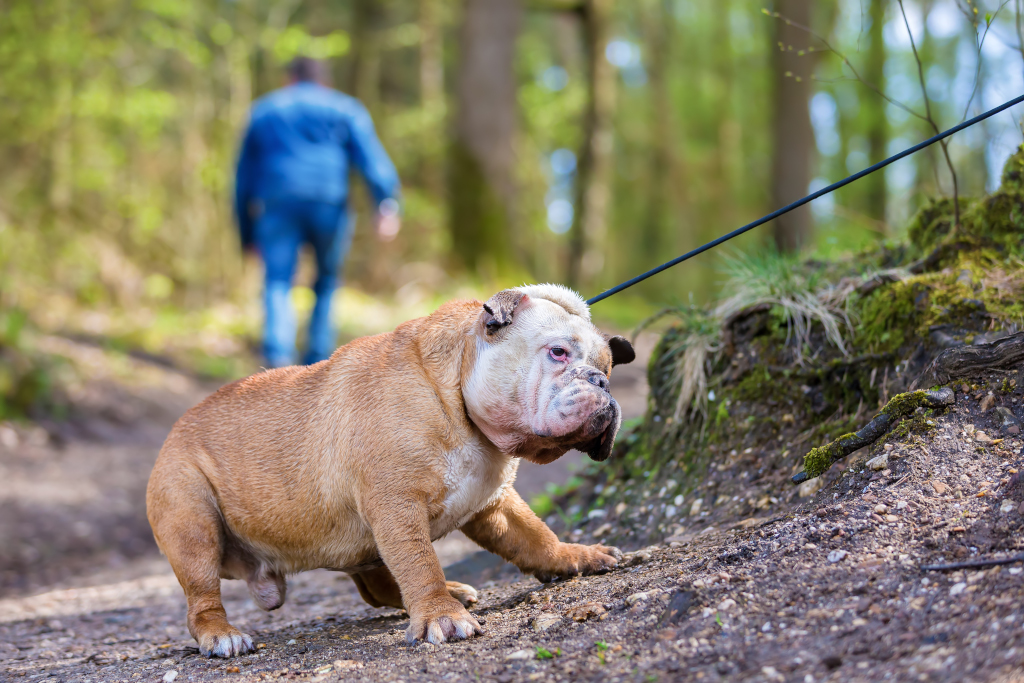
When you take your dog for a walk, does it feel more like a tug-of-war than what you always had pictured – a leisurely stroll?
You’re not alone.
Leash pulling is one of the most common problems many dog owners face. It can be very frustrating and tiring as you constantly find yourself being dragged around the streets!
Fortunately, there are a few ways to stop your pup from pulling on the lead and ensure that you and your canine have a pleasant walk together.
Key Takeaways: How to Keep Your Dog From Pulling on Walks
- Teach your dog loose leash walking, so they know how to walk without pulling.
- Set your dog up for success by redirecting their attention when you feel like they’re about to pull. Don’t let them have the opportunity to pull on the leash in the first place.
- Invest in training tools such as no-pull harnesses to keep your dog from pulling. But don’t just let these tools do all the work for you. Instead, teach your pup leash manners because you want them to learn proper behavior and will walk nicely regardless of the type of harness or collar they wear.
- Exercise your four-legged friend before heading out for a walk to help burn off their extra energy. This will reduce the likelihood of pulling, which will, in turn, help them develop good habits.
- Teach your canine impulse control so that even if something exciting comes across the street, they can resist the urge to pull to get to it.
- Be patient and consistent with your training. It may take time, but eventually, your pooch will learn that pulling on the leash is unacceptable, and you both will only be able to enjoy a walk with no pulling.
#1: Teach Your Dog Loose Leash Walking
No dogs are born knowing leash manners, so the first and foremost thing to do is to teach your pup loose leash walking.
The general idea is that when your fido walks ahead of you and as soon as the leash becomes tight, you stop and wait for them to turn to you. And the moment they do and the leash becomes loose, you praise them and continue walking. What that does is, over time, your canine will learn to walk right beside you and not ahead of you as they know that otherwise, the walking stops.
Always practice this in a place with little distractions, such as inside your home or backyard, where it’s easier for them to focus on what you are asking, and gradually work up to more stimulating places as your pooch gets better.
#2: Redirect Your Dog's Focus
One of the most common mistakes many dog owners make is constantly allowing their pups to pull on the leash to get to wherever they want. Unfortunately, this only reinforces the bad behavior. They’ll get into the habit of pulling on walks because they are always allowed to do so and, therefore, believe that pulling is acceptable.
One way to stop this is by redirecting your canine’s focus away from the things they want to pull towards, or better yet, redirect them before they have a chance to pull. You can do this by using treats or simply changing directions and heading in the opposite direction when you anticipate your pooch is about to pull. This will help them learn to pay attention to you instead of where they want to go and discourage pulling behavior.
#3: Use the Right Equipment
Using the right tool is also key to helping you stop your pup from pulling on the leash. A front-clip harness, for example, can help redirect your dog’s attention away from the distraction and back toward you. Other equipment you also can use include slip leads, remote training collars, martingale collars, prong collars, choke chains, and head halters.
However, one thing to note is that these tools should only be used as a supplement to training, not a replacement. They are meant to help you while you’re in the process of teaching your pup to walk without pulling on the leash. If you rely solely on these tools and don’t actually spend time teaching them proper leash manners, they won’t learn the desired behavior.
That also means your pup will most likely go back to their old habits when you take the equipment off and switch back to a regular collar or harness. And you don’t want that. You don’t want them to only respond to these tools. You want them to be able to walk beside you regardless of the type of collar or harness they are wearing.
Note: Some tools are made for the opposite purpose, like dog joring harnesses. These are designed to encourage dogs to pull for sledding and dog pulling sports. So make sure you invest in the right equipment.
#4: Exercise Your Dog Before Heading Out
Think about the exciting things your pup can see and smell on the street. That alone is enough to get them excited and make it difficult for you to keep them focused while walking. And imagine if you’re walking a dog that hasn’t been taught leash manners and is full of energy. That’s a recipe for disaster!
So make sure that you exercise your pooch before taking them out for a walk. You don’t need to take them through an exhausting workout, but a good game of fetch or tug-of-war in the backyard or simply letting them run around in your fenced yard can help them burn off some of that energy. That way, when you go on a walk with them, they are less likely to pull, and that will, in turn, help them develop good habits and allow you to reinforce the desired behavior.
Yes, I know that the whole point of taking your canine on a walk is to give them exercise, but exercising them is one thing, and teaching them proper leash manners is another. Your goal now is to teach them how to walk nicely on a leash, not just for them to be able to get some exercise.
You May Also Like: How to Exercise My Dog Indoors
#5: Teach Your Dog Impulse Control
Impulse control is a fundamental skill that all dogs should learn, and it’s essential for teaching them to stop pulling. This is basically your dog’s ability to resist the urge to do something they want to do until you allow them. This means that even if there’s a squirrel running across the street right in front of them or something else they want to chase, they can resist the temptation and stay focused on you. To put it simply, it’s self-control.
#6: Be Patient & Consistent
Above all else, when teaching your canine to stop pulling, it’s crucial to be consistent with the training and remain patient, as it can be a long process. Rome wasn’t built in a day, so don’t expect your dog to learn everything overnight, either. Don’t give up, and don’t let your emotions take over if your pup doesn’t seem to be making any progress. With enough practice, they will eventually learn what is expected of them.
Final Thoughts
Not only will teaching your furry friend not to pull on the lead make walks more enjoyable for you and your fido, but it also ensures that they remain safe in public areas. And while it may take some time and effort, all of that hard work will be worth it when you and your pup can enjoy a leisurely stroll with no pulling. Good luck!

